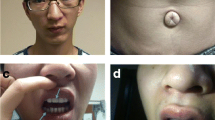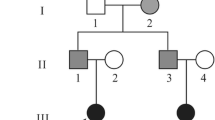Abstract
Cytogenetic analysis of the first child of an older couple afflicted with Down’s syndrome revealed a Robertsonian translocation between the chromosomes 13, 14 in addition to trisomy 21. His mother was found to be a carrier of this translocation with no history of abortion.
Similar content being viewed by others
References
Aurias A, Prieur M, Dutrillaux B, Lejeune J. Systematic analysis of 95 recip-rocal translocations of autosomes.Hum Genet 1978; 45: 259–282.
Stoll C. Non-random distribution of ex-change points in patients with reciprocal translocation.Hum Genet 1980; 56: 89–93.
Lindebaum RH, Hulten M, McDermott A, Seabright M. The prevalence of translocations in parents of children with regular trisomy 21: a possible interchro-mosomal effect?J Med Genet 1985; 22 : 24–28.
Fernhoff PM, Singh DN, Hanson J et al. Association of D/D translocations with fetal wastage and aneuploidt. A report of four families.J Med Genet 1976; 13: 389–393.
Leddet-Chevallier I, Sparkes R. Inherited 13/14 translocation and metacentric mi-crosome associated with trisomy 21: Re-port of 2 cases.Clin Genet 1983; 23: 386–390.
Hungerford DA. Leukocytes cultured from small inocula of whole blood and the preparation of metaphase chromo-somes by treatment with hypotonic KC1Stain Tech 1965; 40:333.
Seabright MA rapid banding technique for human chromosomes.Lancet 1971; ii: 971–972.
Therman E, Susman B, Denniston C. The non random participation of human acro-centrix chromosomes in Robertsonian translocations.Ann Hum Genet 1989; 53: 49–65.
Fruns JP, Kleczkowska A, Kunien E et al. Cytogenetic survey in couples with recur-rent fetal wastage.Hem Genet 1984; 65: 336–354.
Bourrouillou G, Colombies P, Dastugue N. Chromosome studies in 2136 couples with spontaneous abortions.Hum Genet 1986; 74:399–401.
Compana M, Serra A, Neri G. Role of chromosome aberrations in recurrent abortion: a study of 269 balanced translo-cations.Am J Med Genet 1986; 24: 341–356.
Pulliam LH, Huether CA. Translocation Down syndrome in Ohio 1970–1981: Epi-demiologie and cytogenetic factors and mutation rate estimates.Am J Genet 1986; 39:361–370.
Harris DJ, Hankins L, Begleiter ML. Re-productive risk of t(13q 14) carriers: Case report and review.Am J Med Genet 1979; 3:175–181.
Author information
Authors and Affiliations
Rights and permissions
About this article
Cite this article
Sudha, T., Jayam, S. & Ramachandran, R. The association of t (13q, 14q) with Down’s syndrome and its inheritance. Indian J Pediatr 57, 249–252 (1990). https://doi.org/10.1007/BF02722096
Issue Date:
DOI: https://doi.org/10.1007/BF02722096




